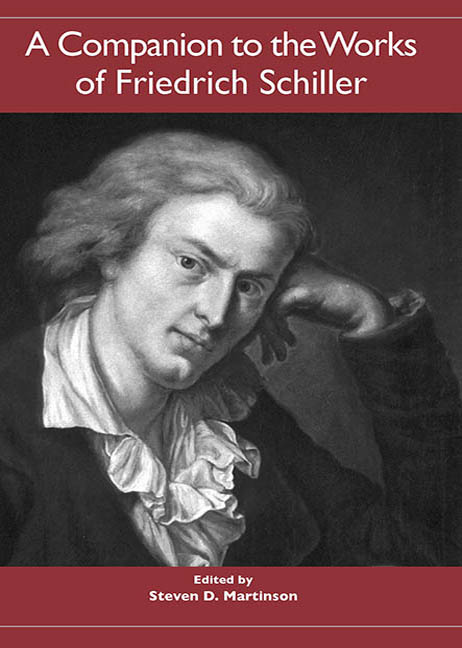Book contents
- Frontmatter
- Dedication
- Contents
- Acknowledgments
- The Works of Friedrich Schiller
- Editions and Abbreviations
- Introduction: Schiller and the New Century
- Intellectual-Historical Settings
- Major Writings
- Die Räuber: Structure, Models, and an Emblem
- Kabale und Liebe Reconsidered
- Great Emotions — Great Criminals?: Schiller's Don Carlos
- Concerning Aesthetic Education
- “On the Shores of Philosophy”: Schiller's Lyric Poetry, 1795
- Wallenstein
- Maria Stuart: Physiology and Politics
- Die Jungfrau von Orleans
- Wilhelm Tell
- Schiller's Legacy
- Works Cited
- Notes on the Contributors
- Index
Concerning Aesthetic Education
from Major Writings
Published online by Cambridge University Press: 28 April 2017
- Frontmatter
- Dedication
- Contents
- Acknowledgments
- The Works of Friedrich Schiller
- Editions and Abbreviations
- Introduction: Schiller and the New Century
- Intellectual-Historical Settings
- Major Writings
- Die Räuber: Structure, Models, and an Emblem
- Kabale und Liebe Reconsidered
- Great Emotions — Great Criminals?: Schiller's Don Carlos
- Concerning Aesthetic Education
- “On the Shores of Philosophy”: Schiller's Lyric Poetry, 1795
- Wallenstein
- Maria Stuart: Physiology and Politics
- Die Jungfrau von Orleans
- Wilhelm Tell
- Schiller's Legacy
- Works Cited
- Notes on the Contributors
- Index
Summary
Über die Ästhetische erziehung des Menschen in einer Reihe von Briefen (known as the Ästhetische Briefe [On the Aesthetic Education of Man in a Series of Letters, or the Aesthetic Letters, 1795]) may be the work by which Friedrich Schiller is best known outside Germany. Its influence has been enormous, and not just in the field of aesthetics but also in political and psychological theory. It expresses a grand vision of human potentialities that has inspired and provoked its readers, while its dazzling moments of insight into the problems of cultural development, into the nature of aesthetic experience, and into the qualities of art objects have given impetus to further reflection and sparked off fruitful debates. The analysis of the effects of the division of labor, the elaboration of the notion of art as play, the notion of Schein or aesthetic semblance, the concept of the aesthetic state — all of these ideas have had an eventful afterlife, though often detached from the matrix of Schiller's argument.
Yet despite their enormous impact and continuing resonance in cultural debates, the Ästhetische Briefe remain difficult to interpret, and many bones of critical contention remain. Does Schiller succeed in bringing his treatise to a satisfactory conclusion in the concept of the aesthetic state and how does such a state relate to the problem of political renewal identified in the early letters? Why does Schiller promise his readers a treatment of “energetic” as well as “melting” beauty but fail to deliver it? Is aesthetic education the means or the end of progress? Does the work represent the quintessence of Schiller's thought on aesthetics, or is it, as I shall argue, only one position in his continuing intellectual odyssey?
The Ästhetische Briefe are the culmination of Schiller's engagement with the nature of the beautiful and with the role of art and aesthetic experience in human development and society. These issues had long been in his mind. As early as 1784 he gave a lecture to the Kurpfälzische Deutsche Gesellschaft which was published under the title Was kann eine gute stehende Schaubühne eigentlich wirken? (What Effect Can a Good Repertory Theater Have?, 1784). Much of the answer Schiller offers reiterates familiar defenses of the theater. At the end of the essay, however, he claims that the theater affords us experience that restores our inner equilibrium and, in so doing, our harmony with our fellow human beings.
- Type
- Chapter
- Information
- A Companion to the Works of Friedrich Schiller , pp. 147 - 168Publisher: Boydell & BrewerPrint publication year: 2005

